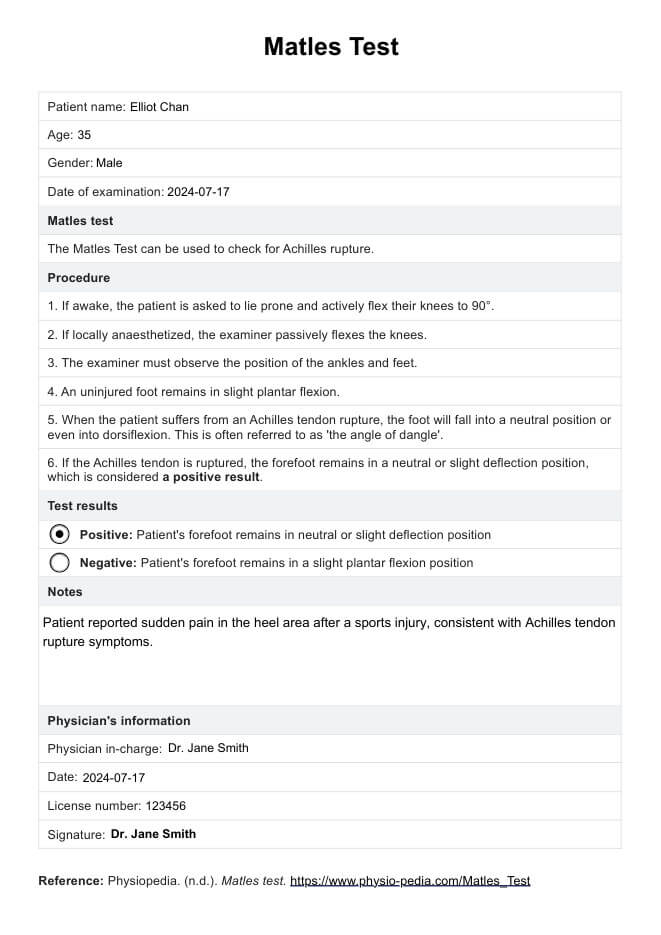Matles Test
Get Carepatron's free PDF download of the Matles Test with examples to help you prepare for your evaluation. Improve your understanding and grasp of the subject with this resource.


What is an Achilles tendon rupture?
An Achilles tendon rupture is a severe injury where the Achilles tendon, which connects the calf muscles to the heel bone, partially or completely subcutaneous tear. This condition, also known as an Achilles tendon tear, typically occurs during activities that involve sudden acceleration or changes in direction, like running or jumping.
Symptoms
Symptoms of a torn Achilles tendon pathology include a sudden, sharp pain in the back of the lower leg, often described as a sensation of being kicked or struck. This is usually followed by swelling and bruising around the ankle. Individuals may experience difficulty walking, especially during activities requiring the push-off phase, due to the inability to perform plantar flexion. A noticeable gap or depression may also be felt along the tendon. These symptoms are key indicators that prompt the need for a clinical diagnosis and appropriate other tests to confirm the Achilles tendon injury.
Causes
The primary cause of an acute Achilles tendon rupture is a sudden, forceful strain on the Achilles tendon. This often occurs during high-impact sports or activities involving sudden accelerations, decelerations, or changes in direction, such as basketball, soccer, or tennis. Other contributing factors include overuse, which can lead to tendon degeneration over time, and pre-existing conditions such as Achilles tendinitis. Additionally, inadequate warm-up, poor conditioning, and the use of certain medications like corticosteroids can weaken the tendon, increasing the risk of a rupture.
Matles Test Template
Matles Test Sample
What is the Matles Test?
The Matles Test is a clinical assessment used to diagnose an Achilles tendon rupture. This diagnostic procedure helps determine the integrity of the Achilles tendon when an Achilles tendon injury, such as an Achilles tendon tear, is suspected.
How is this test conducted?
The Matles Test is a straightforward clinical procedure used to diagnose an Achilles tendon rupture. The process varies slightly depending on whether the patient is awake or locally anesthetized.
The patient lies prone on an examination table and actively flex their knees to a 90-degree angle. If the patient is locally anesthetized, the examiner will passively flex the patient's knees to the same position.
Once the knees are flexed, the examiner observes the position of the ankles and feet. In an uninjured foot, the ankle remains in slight plantar flexion due to the tension of the intact Achilles tendon. However, if the patient has suffered an Achilles tendon rupture, the foot will fall into a neutral position or even into dorsiflexion. This observation, often referred to as 'the angle of dangle,' indicates a loss of tendon integrity.
How are the results interpreted?
As mentioned, a negative result indicates that the Achilles tendon is intact. When the patient’s knees are flexed to 90 degrees, the uninjured foot will naturally remain in slight plantar flexion. This position is due to the tension maintained by a healthy Achilles tendon, which keeps the forefoot pointing slightly downward.
A positive test result suggests an Achilles tendon rupture. In this case, when the knees are flexed to 90 degrees, the forefoot does not maintain the usual plantar flexion. Instead, it falls into a neutral position or even into dorsiflexion.
Next steps after conducting this test
After conducting the Matles Test to assess for an Achilles tendon rupture, the next steps involve confirming the diagnosis and planning appropriate treatment. If the diagnostic test results indicate a positive finding of a ruptured Achilles tendon, further evaluation may include imaging studies such as ultrasound or MRI to assess the extent of the injury and any associated complications.
Clinical examination of the affected area for swelling, bruising, and functional limitations will help guide the treatment plan, which may include non-surgical options like immobilization with a cast or brace, or surgical repair in cases of severe tears. Early intervention is crucial to prevent long-term complications and facilitate optimal recovery.
How to use our Matles Test template
Using Carepatron's Matles Test template can streamline the process of conducting and documenting the Matles Test for diagnosing Achilles tendon ruptures. Here’s a guide on accessing and effectively utilizing the template:
Access the template
Accessing the Matles Test template on Carepatron is simple. Log in to your Carepatron account, navigate to the templates section, and search for "Matles Test." Click on the template to open it and start using it immediately.
Review the test
Before conducting the Matles Test, review the template to familiarize yourself with the procedure and documentation requirements. Ensure that all necessary fields are clear and that you understand the steps involved in performing the other diagnostic test, like a calf squeeze test, accurately.
Introduce the test to the patient
Explain the Matles Test to the patient in clear and understandable terms. Inform them about the purpose of the clinical tests and what to expect during the procedure. Address any questions or concerns they may have to ensure their cooperation and understanding.
Use the test template
During the test, follow the instructions outlined in the Matles Test template. Record the patient's responses and observations accurately within the template. Document any relevant findings, including the position of the forefoot and any signs of ruptured Achilles tendon, to facilitate a comprehensive diagnosis.
Commonly asked questions
The Matles Test is a clinical examination used to assess for an Achilles tendon rupture by observing the position of the forefoot during knee flexion.
The Thompson test evaluates Achilles tendon function by squeezing the calf muscle, while the Matles test assesses tendon integrity by observing the foot's position during knee flexion.
A positive Thompson test indicates an intact Achilles tendon, where squeezing the calf muscle causes the foot to flex downward (plantar flexion).
The sensitivity of the Matles Test refers to its ability to correctly identify Achilles tendon ruptures. Studies indicate high sensitivity, making it a reliable diagnostic tool in clinical practice.







































































































